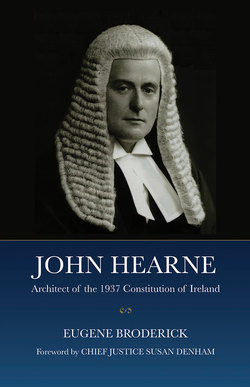Читать книгу John Hearne - Eugene Broderick - Страница 7
ОглавлениеFOREWORD
There has been a significant lacuna in Irish legal history: unlike other jurisdictions, we have not appropriately honoured the draftsmen of our Constitution. For decades, little attention has been paid to the role played in its drafting by public servants, the most influential of whom was John J. Hearne. John Hearne: Architect of the 1937 Constitution redresses this with its in-depth description of Hearne’s role in the creation of Bunreacht na hÉireann, 1937.
This publication is timely, in the eightieth year since the Constitution was enacted in 1937, and as we prepare to celebrate the life and work of John Hearne at a conference in his native city of Waterford. The author tells the story of Hearne, his family life, politics, education and religion, all of which enriched his work as a lawyer, public servant and diplomat, and provides us with a valuable historic account of Hearne’s involvement in the making of the Constitution.
A fascinating insight is also provided into the relationship between Hearne and Éamon de Valera. The seeds of a strong professional relationship were sown following de Valera’s election as President of the Executive Council of the Irish Free State, when Hearne was legal adviser to the Department of External Affairs. After de Valera made the decision to draft a new Constitution, and gave instructions to Hearne to commence the work, their relationship flourished during many hours spent discussing and preparing the basic law, which has shaped our State. De Valera later dedicated a copy to Hearne, whom he described as ‘Architect in Chief and Draftsman’ of the Constitution.
It was a prescient document. Drafted in the 1930s, it set out the framework of government, guaranteed fundamental rights, and gave the power of judicial review expressly to the Superior Courts. These provisions have generated a rich source of case law and a unique jurisprudence. We are fortunate to have such a written Constitution, which the People alone can change.
The author enlightens us about the significant role Hearne played in the inclusion of key provisions. Knowledgeable in constitutional law, he drew from the constitutions of other jurisdictions, in order to advise de Valera and draft the Constitution. His drafts included features of the new Constitution, which remained in subsequent drafts, and found their way into the Constitution as finally adopted.
Eugene Broderick describes how, when de Valera instructed Hearne to draw up the heads of a new Constitution, handwritten notes by de Valera indicate an exchange of views between the two men, during which Hearne advised de Valera on matters including the possibility of a Constitutional Court and the office of President. Both de Valera and Hearne believed that there should be entrenched in the Constitution the power of the Superior Courts to judicially review the compatibility of legislation. In October 1936, Hearne drafted a version of articles relating to judicial review. An independent judiciary, entrusted with the power of judicial review, enabling courts to uphold rights, has been an important aspect of our constitutional democracy ever since.
This book elegantly captures the commitment of John Hearne to the protection of the rights of Irish citizens, and his unwavering service throughout his life to the Irish State. I congratulate the author on a magnificent publication and I recommend this book to everyone interested in the history of our Constitution.
Susan Denham
Chief Justice
Four Courts
Dublin.
January 2017
